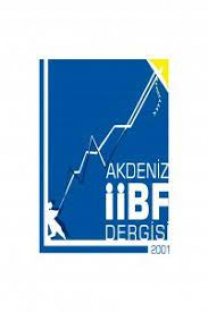Minimum Wage and Average Wage Relationship in Turkey: A Cointegration and Error Correction Analysis
Türkiye'de Asgari Ücret ve Ortalama Ücret İlişkisi: Bir Koentegrasyon ve Hata Düzeltme Analizi
___
- ABOWD, J.M., KRAMARZ, F., LEMIEUX, T., MARGOLIZ, D. (1999) ‘High Wage Workers and High Wage Firms’, Econometrica, 67(3), 251-334.
- BAZEN, S. and MARIMOUTOU, N. (2002) “Looking for a Needle in a Haystack? A Reexamination of the Time Series Relationship between Teenage Employment and Minimum Wages in the United States”, Oxford Bulletin of Economics and Statistics, v 64, 699-725.
- BELL, L. (1997) “The Impact of Minimum Wages in Mexico and Colombia,” Journal of Labor Economics, 15(3), 102-134.
- BELL, N.F., and WRIGHT, E. (1996) ‘The Impact of Minimum Wages on the Wages of the Low Paid: Evidence From the Wage Boards and Councils’, Economic Journal, 106 (May), 650-656.
- BULUTAY, Tuncer (1998) Türk İşgücü Piyasası ile İlgili Temel Gelişmeler, DİE yayınları, Ankara.
- BURKHAUSER R. V., COUCH K. A., and WITTENBURG D. C., (2000) "Who Minimum Wage Increases Bite: Results from the Current Population Survey and Survey of Income and Program Participation," Southern Economics Journal, 67(1) 16-40.
- CARD, D. and KRUEGER, A. B. (2000) ‘Minimum wages and employment: a case study of the fast-food industry in New Jersey and Pennsylvania: Reply’, American Economic Review 90(5), 1397–1420.
- CARD, D. and KRUEGER, A. B. (1995) ‘Time-series minimum-wage studies: a meta-analysis’, American Economic Review 85(2), 238–243.
- CARD, D. and KRUEGER, A. B. (1994) ‘Minimum wages and employment: a case study of the fast-food industry in New Jersey and Pennsylvania’, American Economic Review 84(4), 772–93.
- DAVIDSON, R., and MACKINNON, J.G. (1993) "Estimation and Inference in Econometrics”, Oxford University Press, Oxford.
- DEERE, D., KEVIN M., and FINIS W. (1995) “Employment and the 1990-1991 Minimum-Wage Hike,” American Economic Review, v 85 (2), 232-237.
- DICKENS, R., MACHIN, S., and MANNING, A. (1999) “The Effects of Minimum Wages on Employment: Theory and Evidence from Britain”, Journal of Labor Economics 17(1), 1–22.
- ENDERS, Walter (2004) Applied Econometric Time Series, John Wiley & Sons, Inc., Danvers, MA.
- ENGLE, Robert F. and CLIVE W. J. Granger (1987) “Co-integration and Error Correction: Representation, Estimation and Testing”, Econometrica 55 (2): 251-276.
- FAJNZYLBER, P. (2001) “Minimum Wage Effects throughout the Wage Distribution: Evidence from Brazil’s Public and Private Sectors,” CEDEPLAR Working Paper, No. 151.
- GRAMLICH, E. M. (1976) “Impact of Minimum Wages on Other Wages, Employment, and Family Incomes”, Brookings Papers on Economic Activity, No. 2, 409-461.
- GRANGER, C.W.J. (1983) "Co-integrated Variables and Error-Correcting Models", University of California (San Diego), Discussion Paper No.83-13a.
- GRIFFITHS, W. E., R. C. HILL, and G. G. JUDGE (1993) Learning and Practicing Econometrics, New York: John Wiley & Sons.
- GROSSMAN, J. B. (1983) “The Impact of the Minimum Wage on Other Wages”, Journal of Human Resources, vol. 18, 359-378.
- Istanbul Chamber of Commerce (2005) “Price Indices of Istanbul Chamber of Commerce,” http://www.ito.com.tr/.
- JOHANSEN, S. and JUSELIUS, K. (1990) “Maximum Likelihood Estimation and Inference on Cointegration –with Applications to the Demand for Money, Oxford Bulletin of Economics and Statistics,” 52, 2, 169-210.
- KEIL M., ROBERTSON, D., and SYMONS J., (2001) “Minimum Wages and Employment” Centre for Economic Performance-London School of Economics and Political Science, London.
- KRAMARZ F., and PHILIPPON, T., (2001) “The Impact of Differential Payroll Tax Subsidies on Minimum Wage Employment,” Journal of Public Economics, 82, 115-146.
- KRUEGER, A. B. (2001) ‘Teaching the minimum wage in Econ 101 in light of the new economics of the minimum wage’, Journal of Economic Education 32(3), 243–258.
- LANG, Kevin, and SHULAMIT Kahn. (1998) "The Effect of Minimum-Wage Laws on the Distribution of Employment: Theory and Evidence." Journal of Public Economics. 69: 67-82.
- MACHIN, S. and MANNING, A. (1997) “Minimum wages and economic outcomes in Europe,” European Economic Review 41(3–5), 733–742.
- MALONEY, W. F. and NUNEZ M, J. A. (2003) "Measuring the Impact of Minimum Wages: Evidence from Latin America" NBER Working Paper No. W9800.
- MILLS, J., KAKOLI R., and NICOLAS W. (1999) “Recent Minimum Wage Increases and the Minimum Wage Labor Force,” Journal of Labor Research, XX, 479-492. Ministry of Labor and Social Security, http://www.calisma.gov.tr
- NEUMARK, D., (2001) "The Employment Effects of Minimum Wages: Evidence from a Prespecified Research Design," Industrial Relations, 40(1), 121-144.
- NEUMARK, SCHWEITZER and WASCHER (2000) ‘The effects of minimum wages throughout the wage distribution’, NBER Working Paper 7519.
- PARTRIDGE, D. and PARTRIDGE, J. (1999) “Do Minimum Wage Hikes Reduce Employment? State-level Evidence”, Journal of Labor Research, Summer, vol. 20, no 3, 393-413.
- RAMA, M. (2001) "The Consequences of Doubling the Minimum Wage: The Case of Indonesia." Industrial and Labor Relations Review 54(4): 864-81.
- State Planning Organization, http://www.dpt.gov.tr/
- State Institute of Statistics, http://www.die.gov.tr/
- STOCK, James H. and WATSON, Mark W. (2003) Introduction to Econometrics, Addison Wesley.
- STROBL, E. and F. WALSH (2003) "Minimum Wages and Compliance: The Case of Trinidad and Tobago," Economic Development and Cultural Change, 51(2), 427-450.
- ISSN: 1302-9975
- Yayın Aralığı: Yılda 2 Sayı
- Başlangıç: 2001
- Yayıncı: Akdeniz Üniversitesi
Kriz Sonrası Süreçte Türkiye Ekonomisinde Uygulanan Döviz Piyasası Müdahalelerinin Etkinliği
Tamer BOLAT, Oya SEYMEN AYTEMİZ
İşsizlik Sigortasının Sosyal ve Ekonomik Etkileri
Türkiye'de illerarası Fiyat Yakınsaması
Küresel Kamu Malları: Hegemonya ve İstikrarın Küresel Ekonomi Politiği
Süleyman ULUTÜRK, Servet AKYOL
The Social Costs of Monopoly: A Survey and an Evaluation
Minimum Wage and Average Wage Relationship in Turkey: A Cointegration and Error Correction Analysis
